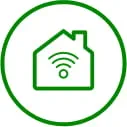In 2024, the FCC required internet service providers to supply a "broadband nutrition label" to their products. Like food labels that help consumers determine how an item will affect their nutrition and diet, these labels help internet consumers understand everything that goes into their internet services.
What goes into a broadband nutrition label?
Broadband nutrition labels are an innovative approach to providing consumers with transparent and easily understandable information about the quality and performance of their internet connection. Inspired by the simplicity of food nutrition labels, these broadband labels aim to empower users with insights into key metrics that define their online experience. The idea for including a "nutrition label" on internet products aims to alleviate customer concerns about things like hidden fees, allowing them to comparison shop and choose the right internet service for their needs.
Broadband nutrition labels contain the following information:
Speed:
- Download speed: The rate at which data is transferred from the internet to your device.
- Upload speed: The speed at which data is sent from your device to the internet.
Latency:
- The delay between sending a request and receiving a response, often crucial for real-time applications like video calls and online gaming.
Data usage:
- Clearly defined limits on the amount of data you can use within a specified period.
Prices and fees:
- Monthly rate, additional fees and whether this is an introductory rate, early termination fees and taxes.
- Any discounts.
Network management and privacy polices
- Easy access to the "fine print" as well as clear links to customer support.
Benefits of broadband nutrition labels
Broadband nutrition labels follow standardized metrics to allow customers to understand what they're paying for and what they're getting. This will (hopefully) clear up a lot of mystery and confusion around internet bills, which can be laden with fees and information that's impenetrable to the average consumer.
Broadband nutrition labels will indicate any additional fees and encourage providers to be more honest and transparent in their pricing.
Broadband nutrition labels should help ISPs gain trust from customers in an industry that many see as "all the same" -- allowing the best ISPs to rise to the top.
How do broadband nutrition labels affect fiber-optic internet?
While some ISPs aren't keen on the idea of having to untangle and expose their inner workings, ISPs like Ziply Fiber aren't worried about them -- because they have nothing to hide in the first place.
For instance, all our speed tiers are symmetrical, meaning that if you purchase a 300/300 speed plan, you'll be getting up to 300 Mbps download speed and 300 Mbps upload speed (speeds will always be slower due to signal strength unless you're connected via Ethernet). Other ISPs, especially cable-based ISPs, have upload speeds significantly slower than download speeds. With a nutrition label, that information is front and center for all to see -- as much as they may not want you to notice.
With fiber-optic internet at Ziply Fiber, you get what you pay for with no hidden fees. Our plans come with no data caps (data plans are an easy way for telecommunications companies to get customers to overspend when they go over their monthly data allowance) and an assurance of low latency and no peak-time slowdowns due to our superior fiber network.
And we don't engage in any sneaky business, like bundles and annual contracts, which can get you locked into services you don't want to pay for. The only thing to be aware of is if you're starting out on a promotional offer that will end after 12 months. But this is all clear on the nutrition label, so you won't be surprised.
Customer empowerment
Broadband nutrition labels are a step toward a more transparent and consumer-centric internet landscape. As we continue to rely on digital connectivity for various aspects of our lives, having access to clear and standardized information about our internet service is paramount. Just as we look out for our health by reading food labels, broadband nutrition labels empower us to make choices that align with our digital well-being and empower us to be informed decision-makers in the ever-expanding digital world.






